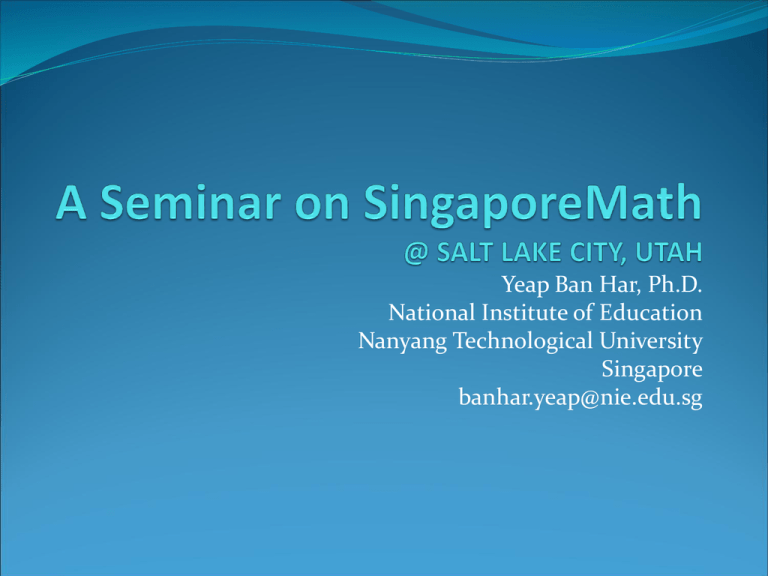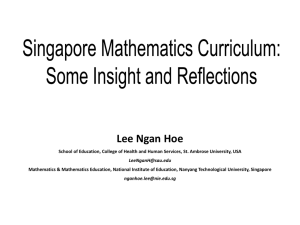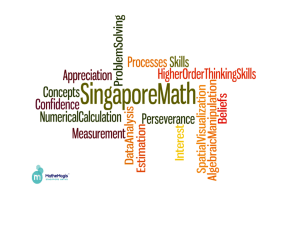Mathematical Problem Solving
advertisement

Yeap Ban Har, Ph.D. National Institute of Education Nanyang Technological University Singapore banhar.yeap@nie.edu.sg A multi-racial, multi-cultural, multi-religious and multi-lingual society. Gained independence in 1965. Population of 4 million with ½ million students in about 350 schools, all public. Presentation Outline Singapore Education in a Nutshell Singapore Mathematics Curriculum National Tests in Singapore Mathematics Teaching in Singapore Mathematics Teachers & Professional Development Achievements of Singapore Students Questions & Discussion Development & Focus Moulding the Future of the Nation Thomas L. Friedman 2006 The World Is Flat Thomas L. Friedman 2006 The World Is Flat Nurturing Knowledge Workers through Ability-Driven Education Beaton, Mullis, Martin, Gonzalez, Kelly & Smith 1996 The Singapore mathematics curriculum states that “an emphasis on mathematics education will ensure that we have an increasingly competitive workforce to meet the challenges of the 21st century” Schools around the world are forced to move forward if they want to make a difference to the future of their students. Agenda for Action (USA) and Cockcroft Report (UK) led to the introduction of a problem-solving curriculum in 1992. Singapore Mathematics Curriculum Framework Beliefs Interest Appreciation Confidence Perseverance Numerical calculation Algebraic manipulation Spatial visualization Data analysis Measurement Use of mathematical tools Estimation Monitoring of one’s own thinking Self-regulation of learning Mathematical Problem Solving Concepts Numerical Algebraic Geometrical Statistical Probabilistic Analytical Reasoning, communication & connections Thinking skills & heuristics Application & modelling This initiative was introduced in 1997. It focuses on explicit teaching of thinking through school subjects. It was revised in 2001 to give more emphasis on a range of heuristics. This initiative was introduced in 2003. It focuses on inculcating good habits of minds amongst students. This call was made in 2004 to encourage the development of strong foundation knowledge. Sample Test Item 3 cm 5 cm 3 cm 7 cm Find the area of the figure shown. 3 cm 5 cm 3 cm 7 cm Find the area of the figure shown. 3 cm 5 cm 3 cm 7 cm Find the area of the figure shown. 3 cm 5 cm 3 cm 7 cm Find the area of the figure shown. This call has been made since 2005. Every child should be developed to maximize their potential using different approaches. Technological advances have compelled educators to re-consider what is considered significant in school curriculum. Kaput, Noss & Hoyles 2002 It was revised in 2007 for this reason. It places greater emphasis on visualization and number sense. With the introduction of calculator, mental strategies are also emphasized. PSLE: Emphasis on Visualization The figure below is made up of 2 identical squares, 4 identical rectangles and 3 identical semi-circles. What is the area of the figure? 70 cm PSLE: Emphasis on Number Sense Each of the three cards shown is printed with a different whole number. The smallest number is 23. When these numbers are added two at a time, the sums are 61, 71 and 86. What is the largest number on the cards? 23 It is recognized that mathematics is “an excellent vehicle for the development and improvement of a person’s intellectual competence in logical reasoning, spatial visualization, analysis and abstract thought” Ministry of Education Singapore 2006 Emphasis on Basics & Problem Solving National Tests in Singapore Grade 6 Primary School Leaving Examination PSLE Has always been under the control of Singapore Ministry of Education Singapore Examinations and Assessment Board (SEAB) was set up recently to handle national tests in Singapore Grade 10 GCE Ordinary Level Has always been offered by Cambridge Examination Syndicate until 2008. Grade 12 GCE Advanced Level Has always been offered by Cambridge Examination Syndicate until 2007. PSLE Paper 1 50 minutes MultipleChoice Items 10 5 1m 2m 10% 10% Short-Answer Items 10 5 1m 2m 20% PSLE Paper 2 1 hour 40 minutes Short-Answer Items Structured & Long-Answer Items 5 2m 10% 13 3m 4m 5m 50% Knowledge 25% Recall specific mathematical facts, concepts, rules, and formulae. Perform straight-forward computations Comprehension 35% Interpret data Use mathematical concepts, rules, and formulae Solve routine or familiar problems Application & Analysis 40% Analyse data Apply mathematical concepts, rules and formulae in a complex situation Solve unfamiliar problems Basic & Routine Skills Example 1 Find the value of 12.2 ÷ 4 . Example 2 A show started at 10.55 a.m. and ended at 1.30 p.m. How long was the show in hours and minutes? Basic & Routine Skills Example 3 Find <y in the figure below. 70o 70o y 70o Basic & Routine Skills Example 4 Cup cakes are sold at 40 cents each. What is the greatest number of cup cakes that can be bought with $95? Example 5 From January to August last year, Mr Tang sold an average of 4.5 cars per month, He did not sell any car in the next 4 months. On average, how many cars did he sell per month last year? Students are expected to handle novel situations i.e. those not in the textbooks or previous examinations. Problem Solving 1 + 2 + 3 + 4 + 5 + … + 95 + 96 + 97 The first 97 whole numbers are added up. What is the ones digit in the total? Problem Solving Rena used stickers of four different shapes to make a pattern. The first 12 stickers are shown below. What was the shape of the 47th sticker? ………? 1st 12th 47th Students are expected to handle multi-step problems with some degree of complexity. Problem Solving In Figure 1, Tank A is completely filled with water and Tank B is empty. Water is poured from Tank A into Tank B without spilling. The heights of the water level in the two tanks are now equal as shown in Figure 2. What is the height of the water level in Tank A in Figure 2? Problem Solving Siti started saving some money on Monday. On each day from Tuesday to Friday, she saved 20 cents more than the amount she saved the day before. She saved a total of $6 from Monday to Friday. How much money did she save on Monday? Problem Solving Siti started saving some money on Monday. On each day from Tuesday to Friday, she saved 20 cents more than the amount she saved the day before. She saved a total of $6 from Monday to Friday. How much money did she save on Monday? $6 Problem Solving Siti started saving some money on Monday. On each day from Tuesday to Friday, she saved 20 cents more than the amount she saved the day before. She saved a total of $6 from Monday to Friday. How much money did she save on Monday? $4 Such visual methods are given emphasis in place of the more abstract algebraic methods. Berm and Mei saved B800 altogether. A quarter of Berm’s savings was B65 more than a fifth of Mei’s savings. How much was Berm’s savings? Problem Solving David and Michael drove from Town A to Town B at different speeds. Both did not change their speeds throughout their journeys. David started his journey 30 minutes earlier than Michael. However, Michael reached Town B 50 minutes earlier than David. When Michael reached Town B, David had travelled 4/5 of the journey and was 75 km away from Town B. 4 fifths A 75 km B Problem Solving David and Michael drove from Town A to Town B at different speeds. Both did not change their speeds throughout their journeys. David started his journey 30 minutes earlier than Michael. However, Michael reached Town B 50 minutes earlier than David. When Michael reached Town B, David had travelled 4/5 of the journey and was 75 km away from Town B. What was the distance between Town A and Town B? How many kilometers did David travel in 1 hour? What was the time taken by Michael to travel from Town A to Town B? Problem Solving 4 fifths 75 km B A 1 fifth 75 km 4 fifths 4 x 75 km = 300 km The distance between the two towns is 375 km. 50 min 75 km 10 min 75 km ÷ 5 = 15 km 60 min 15 km x 6 = 90 km David traveled 90 km in 1 hour. 90 km 1 h 360 km 4 h 15 km 10 min 375 km 4 h 10 min David took 4 h 10 min. Michael took .............. In Grades 5 and 6, students who have not mastered foundation knowledge follows a Foundation Mathematics program which ensures students master enough mathematics to continue with program in Grade 7 and beyond. Problem Solving in Foundation Mathematics Aini used 1-cm square tiles to make rectangles as shown below. She recorded the area and perimeter of 3 such rectangles in the table shown. Problem Solving Complete the table above for Pattern 4 and Pattern 5. Pattern Area of the rectangle in cm2 Perimeter of the rectangle in cm Pattern 1 3 8 Pattern 2 8 12 Pattern 3 15 16 Pattern 4 24 Pattern 5 24 Problem Solving She made a rectangle of area 80 cm2. What is the pattern number of this rectangle? What is the perimeter of this rectangle? Problem Solving for High-Achievers Grade 10 A fly, F, starts at the point with the position vector (i +12j) cm and crawls across the surface with a velocity of (3i + 2j) cm s-1. At the instant that the fly starts crawling, a spider, S, at the point with position vector (85i + 5j) cm, sets off across the surface with a velocity (-5i +kj) cm s-1, where k is a constant. Given that the spider catches the fly, calculate the value of k. Students are expected to make sense and interpret the mathematics they perform. Features of SingaporeMath The use of appropriate manipulatives. These are common manipulatives that have inexpensive alternatives Focus on key concept – what it is, and what it is not Definitions are developed through induction, starting in an informal fashion Opportunities to make connections to previously taught concept - half Mathematical terms are explained. Designed for learners of English language … .. providing other learning opportunities for learners fluent in the language Opportunities for immediate formative assessment Teachers know the content that they are assessing. Teachers have opportunities to learn content knowledge. The program was designed for teachers who do not necessarily have strong mathematics background. Opportunities for the majority to reach proficient level … .. opportunities to engage advanced learners Provides independent practice Provides opportunities for student-constructed responses Practice for the key concept Comparing Areas (Biggest) Even as a new concept is introduced … .. learners are given practice on recently-learnt materials Comparing Areas (Smallest & Greatest) Comparing Areas (Same Size) Building upon previously developed concepts Non-standard unit Standard unit Concrete Pictorial Abstract Opportunities to develop abstract ideas Providing challenging materials for advanced learners while the rest reach a level of mastery for basic materials Non-standard unit Standard unit Focus on key concept – what it is, what it is not Many opportunities to learn More formal definitions are provided if appropriate Students are finding area of figures (previously learnt content) even as they find the perimeters (new content) Opportunities to help struggling students to reach mastery Opportunities for proficient students to not develop common misconceptions, e.g. confusion between area and perimeter Opportunities for advanced students to make new connections A collection of tasks is usually not a random but purposeful collection Opportunities to help struggling students to reach mastery Visuals are prevalent in mathematics eaching and learning in Singapore textbooks. Example Example Are these four-sided shapes? Example Base Ten Blocks Example Example Explain who is correct. Write in your notebook. Example At first, Shop A had 156kg of rice and Shop B had 72kg of rice. After each shop sold the same quantity of rice, the amount that Shop A had was 4 times that of Shop B. How many kilograms of rice did Shop A sell? 156 kg 72 kg Designing Practice Practice is not repetition. Practice provides variation. Practice for intellectual development. Professional Development http://www.nie.edu.sg Teacher Training Initial Teacher Training Diploma in Education (2 years) for non-graduates Postgraduate Diploma in Education (1 year) for graduates Bachelor of Science / Arts (Education) for non-graduates (2 years) Qualifications of Teachers Level Primary Secondary Junior Colleges NonGraduates Graduates 5 928 6 669 1 070 10 602 Education Statistics Digest 2007 11 2 524 Teacher Training In-service Teacher Training Teachers are entitled to 100 hours of professional development per year. A range of professional development program is available – in-house or by NIE, MOE, leading to certification or otherwise, professional development leave and conferences Teacher Training Initial Teacher Training Diploma in Education (2 years) for non-graduates Postgraduate Diploma in Education (1 year) for graduates Bachelor of Science / Arts (Education) for non-graduates (2 years) TIMSS 2003 International Benchmark Grade 4 Mathematics Performance 91% 73% 64% Singapore 38% International Average 33% 8% Advanced High Intermediate International Benchmark Grade 8 Mathematics Performance 93% 77% 51% 44% Singapore International Average 24% 6% Advanced High Intermediate Comparison between Grade 4 and Grade 8 Mathematics Performance 93% 91% 77% 73% 64% 51% 44% 38% High 33% 24% 8% Grade 4 Grade 8 Singapore 6% Grade 4 Advanced Grade 8 International Intermediate







